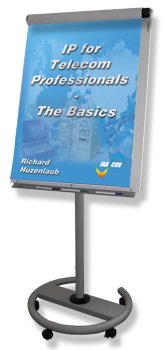 IP for Telecom Professionals -
IP for Telecom Professionals -
Module 2: The Basics
[3-day course, Euro 3,450.- (net) per participant]
 Overview and Basic Considerations about IP Networks
Overview and Basic Considerations about IP Networks

- Logical Structure of Networks
(Star, Ring, Bus, Meshed) - Packetization and Multiplexing
- Network Entities
(Hub, Bridge, Switches, Router, Gateway, Layer-3 Switching) - Ethernet
(10Base-5, 10Base-2, 10Base-T, 10Base-FB & 10Base-FL, 100Base-T &100Base-FX, 1000Base-xx, 10GBase-xx), Access Scheme (CSMA/CD), Frame Types, MAC-Addresses, Manufacturer Codes, Type Field. - PRACTICE:
- Introduce the architecture of our Test Network
- Introduce the Client Windows network dialogs / PC Network Roadmap
- First Configuration Option: Connect the PCs peer to peer for simple home network configuration, introduce NetBui and other Windows low level tools.
- Access the other peer’s file systems, access rights for files, folders and resources
- Assign fixed IP addresses.
 Point to Point Protocol
Point to Point Protocol
- The Point-to-Point Protocol (PPP)
Frame Types, Protocols (LCP, IPCP, CHAP, PAP) - Authentication and Network Layer Setup
- Example for Dial-Up Network Access using the PPP
- PRACTICE:
- Install Hub and Switch – 2 workgroups with 4 members each
- Introduce embedded Windows tools (ping, ipconfig)
- Determine MAC Addresses of the different NICs in our Sub-Network, relate MAC Addresses to IP addresses,
- How many MAC addresses are assigned to our Client PCs, what is the relationship between MAC Addresses and NICs?
 Overview of the TCP/IP Protocol Suite and Addressing in IP Networks
Overview of the TCP/IP Protocol Suite and Addressing in IP Networks
- Introducing the IP-Protocol Stack
(ARP and RARP, IP, RIP, OSPF, TCP, UDP, SCTP, ICMP, DNS, DHCP, HTTP, FTP, SMTP, POP3, RTP / RTCP,…) - Details of the Internet Protocol
(IP-Addresses, IP-Address Classes (A, B C, D, E), Special IP-Address Notations, Subnet-Addressing, Supernetting and CIDR) - Network Address Translation (NAT)
- Functions of DHCP and DNS
- ARP and RARP
Their meaning in a network - PRACTICE:
- Add the Server to our Sub-network (2 workgroups)
- Some basics about our LINUX Server, Roadmap, Introduce specific tools and utilities.
- Configure Router and DHCP Server function on the server PC
- Determine new MAC Addresses and related IP Addresses.
- Modify the Clients to enable automatic IP address allocation through DHCP
- Review all MAC and IP Addresses and compare to previous Practice session – what has changed, how and why?
 Details of the Internet Protocols (IPv4, IPv6)
Details of the Internet Protocols (IPv4, IPv6)
- The IPv4-Header and the IPv6-Header
Differences IPv4 / IPv6 - Details of the Internet Control Message Protocol (ICMP) , Ping
- Switching / Routing / Differences, Routing Mechanisms and Routing Protocols (RIP, OSPF)
- PRACTICE:
- Configure our NAT Router.
- Introduce Ethereal as trace tool
- Pings, Ethereal recordings in our Test Network
 Details of the Transport Protocols (TCP, UDP, SCTP)
Details of the Transport Protocols (TCP, UDP, SCTP)
- Details of the User Datagram Protocol (UDP)
(Port Numbers, "Well known" Port Numbers, the UDP-Header.) - Details of the Transmission Control Protocol (TCP)
(Services of TCP, the TCP-Header, Port Numbers, "Well known" Port Numbers, RTT, SRTT and RTO, Sliding Windows, Slow Start, Congestion Avoidance, Fast Retransmit and Fast Recovery) - Details of the Stream Control Transmission Protocol (SCTP)
(The SCTP Header, Chunk Types, SCTP in the Signalling Gateway (SIGTRAN), Differences to TCP and UDP) - Functions of the Resource Reservation Protocol (RSVP)
- PRACTICE:
- Add the WLAN interface to our Test Network.
- Determine new MAC addresses and related IP addresses.
- Configure and analyse routing tables.
- Browse to INACON internet domain and record the setup with Ethereal.
 Overview of important IP Applications
Overview of important IP Applications
- The Realtime Transport Protocol (RTP) and Realtime Transport Control Protocol (RTCP)
(RTP Header Format, Operation of RTP and RTCP, RTP Frame Example, Tasks and Functions of RTCP, RTCP Frame Example) - The Hypertext Transfer Protocol (HTTP)
(Message Format, Operation of HTTP, Example of HTTP Transactions) - The File Transfer Protocol (FTP)
(Well known Port numbers, FTP Operation, File Transfer Example) - E-Mail Applications: POP3 and SMTP
(Operation of SMTP and POP3, Port numbers, SMTP transaction, POP3 message retrieval, SMTP and POP3 command sets and Message Formats) - PRACTICE:
- FTP access and File Download from our Server and from INACON web site.
- Evaluate routes using Traceroute tools
- Sending and receiving mail in our Test Network
- Evaluate the files recorded with Ethereal
 TCP/IP in the Mobile Environment / Advanced Features
TCP/IP in the Mobile Environment / Advanced Features
- Delayed Response, Implications of Slow Start, Congestion Avoidance and Selective Acknowledgements (SACK) in the mobile environment, the Bandwidth Delay Product, The RTT, SRTT and RTO, implications of handover and cell changes on the performance, the Receiver Window Size.
- PRACTICE:
- Browse the INACON Encyclopaedia and record the access session.
- Access the Swisscom domain and record the session. Analyse the error messages in the trace.
v1.6
ℹ️ Try out the updated search below!
Search:
More Info:
General Information about this course
Schedule of this training course
Extract of this training course
Buy this book
INACON eBooks
Please have a look at our full offer

